 We’re staying in a great apartment with a long terrace overlooking the Coliseum, I mean literally overlooking the Coliseum. The building sits on the the ancient Fagutale Hill, via del Fagutale in the Rione Monti of Rome. This is Rione 1, the first neighborhood of Rome, and the oldest in the city.
We’re staying in a great apartment with a long terrace overlooking the Coliseum, I mean literally overlooking the Coliseum. The building sits on the the ancient Fagutale Hill, via del Fagutale in the Rione Monti of Rome. This is Rione 1, the first neighborhood of Rome, and the oldest in the city.
The Monti are the ancient hills that once included the Esquiline, Viminal, Caelian, Fagutale, Oppian and Quirinale. The Esquiline and Caelian hills have now moved on to other Rione. Redistricting is a bitch.
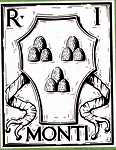 The Rione Monti emblem has three groups of green hills on a silver background. This is not the flat tourist area close to the river. You get a workout in the Monti. It’s a good hike up and down, reminiscent of San Francisco except the streets are harder to navigate. The cobblestones look picturesque but they can destroy your feet in less than 3 hrs. Tire repair is a big business in Rome.
The Rione Monti emblem has three groups of green hills on a silver background. This is not the flat tourist area close to the river. You get a workout in the Monti. It’s a good hike up and down, reminiscent of San Francisco except the streets are harder to navigate. The cobblestones look picturesque but they can destroy your feet in less than 3 hrs. Tire repair is a big business in Rome.
From what is left of the Fagutale Hill we look down to the Coliseum, the Temple of Venus and Rome in the Forum and the Arch of Constantine. From windows on the other side of the apartment we can see the chariot and four horses of the quadriga sitting atop the National Monument to Vittorio Emanuele II in Piazza Venezia.
The Monti was once known as the Suburra, birthplace of Julius Caesar and home to some the most famous brothels of ancient Rome. I read it’s still home to some pretty famous brothels.
Tourists come by the thousands to the Coliseum and the Monti churches but they don’t stay here. They all go back to the Piazza Navona, Campo dei Fiore, the Pantheon, Piazza di Spagna and Piazza del Popolo. Even the Trastevere is more populated with tourists than the Monti. I’m sure in a few more years this area will get more gentrified but for now it has remained a bit removed and that’s OK with us. It’s nice and quiet. Of course, this is November. We’ll see what it’s like in June when we come back.
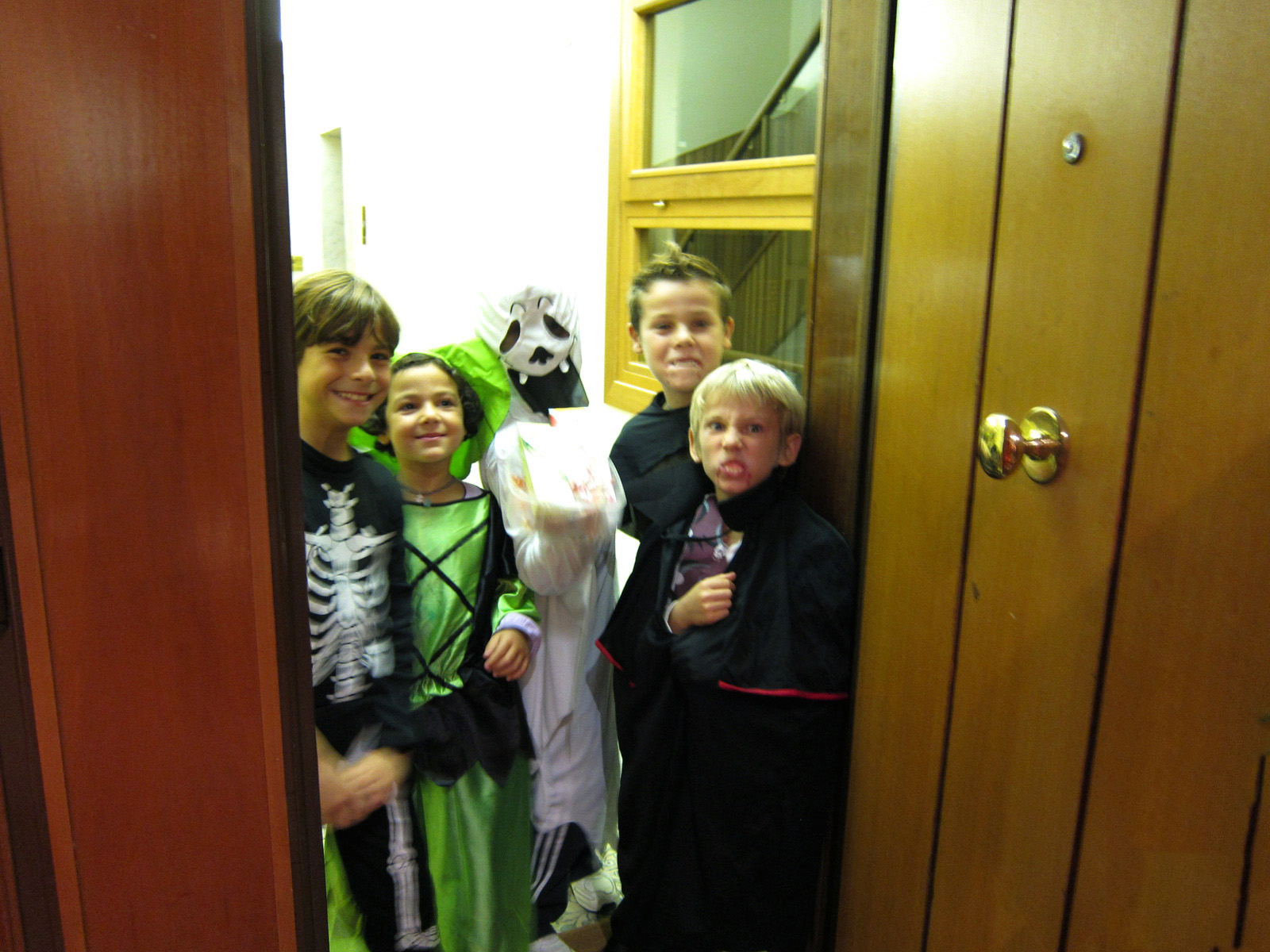 The downside of our apartment is the building itself. It was built in the 1960s and it stands out as an insult to the beautiful 18th and 19th century buildings on the hill. But then it’s better to sit on the terrace of an ugly building and look out at all the beautiful architecture then it is to sit in a beautiful building and look out at an ugly building. We’re told that other residents of the building include film stars and politicians. In our two weeks here we met a few trick-or-treating kids from across the hall on Halloween and a man with his mother in the elevator. The kids could not have been more excited when they discovered we were from America, although they though San Francisco was in Florida.
The downside of our apartment is the building itself. It was built in the 1960s and it stands out as an insult to the beautiful 18th and 19th century buildings on the hill. But then it’s better to sit on the terrace of an ugly building and look out at all the beautiful architecture then it is to sit in a beautiful building and look out at an ugly building. We’re told that other residents of the building include film stars and politicians. In our two weeks here we met a few trick-or-treating kids from across the hall on Halloween and a man with his mother in the elevator. The kids could not have been more excited when they discovered we were from America, although they though San Francisco was in Florida.
Behind our apartment, on the Oppian Hill sits the Church of San Pietro in Vincoli and the famous tomb of Pope Julius II (della Rovere), more commonly know to tourists as Michelangelo’s Moses. Michelangelo sculpted the Statue of Moses and three statues on the bottom of the Julius tomb. The rest was done by “others”. The original tomb concept was much larger (40 figures) and created for a place in St Peters Basilica, but it ended up as a smaller tribute (7 figures) in a smaller church. The Popes seem to lose a lot of influence after their deaths. Payback is a bitch, especially when you’ve amassed as many enemies as Pope Julius II.
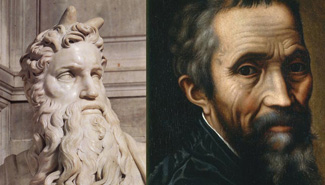 We saw an exhibit of Renaissance art in the Palazzo Sciara on via del Corso and there was a portrait of Michelangelo positioned next to an exact copy of the Moses statue. It sure looks like Michelangelo put his own face in the statue of Moses.
We saw an exhibit of Renaissance art in the Palazzo Sciara on via del Corso and there was a portrait of Michelangelo positioned next to an exact copy of the Moses statue. It sure looks like Michelangelo put his own face in the statue of Moses.
By the way, the horns on the head of Moses were (as most know) intended to show the radiance of light coming from him. Unfortunately through the years, many believed the statue was, in fact, revealing that all Jews had horns. I know it sounds stupid, but one can never underestimate stupidity. As a kid in the 1950s I actually heard people swear to it as a fact. Id be willing to bet there are still people in this world who will swear to it. As I said, one can never underestimate stupidity.
The church of San Pietro in Vincoli was originally built in 432 to house the chains that bound St Peter when he was a prisoner in Jerusalem. At the ceremony, when Pope Leo the Great (Leo I) received the chains he said they actually looked more like the chains St Peter wore when he was a prisoner in the Mamertine Prison in Rome. Leo the Great was the Bishop of Rome 400 years after Peter died, and how he knew one set of Roman chains from another is an amazing bit of historical sleuthing, but whatever, as soon as he proclaimed the two chains to be those of St Peter, they magically joined together into one chain and are now preserved in a glass case under the alter of the church. Leo the Great, by the way, was the pope who persuaded Attila the Hun not to invade Rome in 452. Personally, I think this was a more impressive achievement than making two chains into one.
Behind San Pietro in Vincoli, up on the Oppian hill are the remains of both the Baths of Titus and the Baths of Trajan. They sit on top of Nero’s fabulous “Golden House”, the “Domus Aurea”, which is once again closed to the public. Every time it opens up, something falls from one of the large vaulted ceilings. Most of it was built underground to keep the rooms cool. There was a very clever way of redirecting the light to illuminate the rooms and if you walk around the grounds you can still still some of the octagonal domes where light was once collected and redirected. The Palace was filled with amazing architectural achievements but unfortunately they were built and paid for one of the most hated Emperors of all time. Actually he was only hated by the Senate and the wealthy families. The people of Rome kind of liked him.
After the death of Nero (he killed himself before someone else killed him) the newly installed Flavian Dynasty tried to remove all Nerone traces from the empire. His lake was drained and turned into the Coliseum, part of his Golden House was converted into the new Temple of Venus and Rome and large public baths were built over the remains of the underground sections of the Palace. The Golden House wasn’t really rediscovered until the 1500s when a boy fell through a hole in the ground near the baths of Trajan. He found himself face to face with the grotesque art of the Domus walls that became very popular during the Renaissance.
The Domus has been opened and closed quite a few times in recent years. In 2010, 60 square meters of one of the gallery vaults collapsed. It hasn’t reopened since but I’m sure it will. Things open and close all the time in Rome. Its one of the reasons we keep coming back.
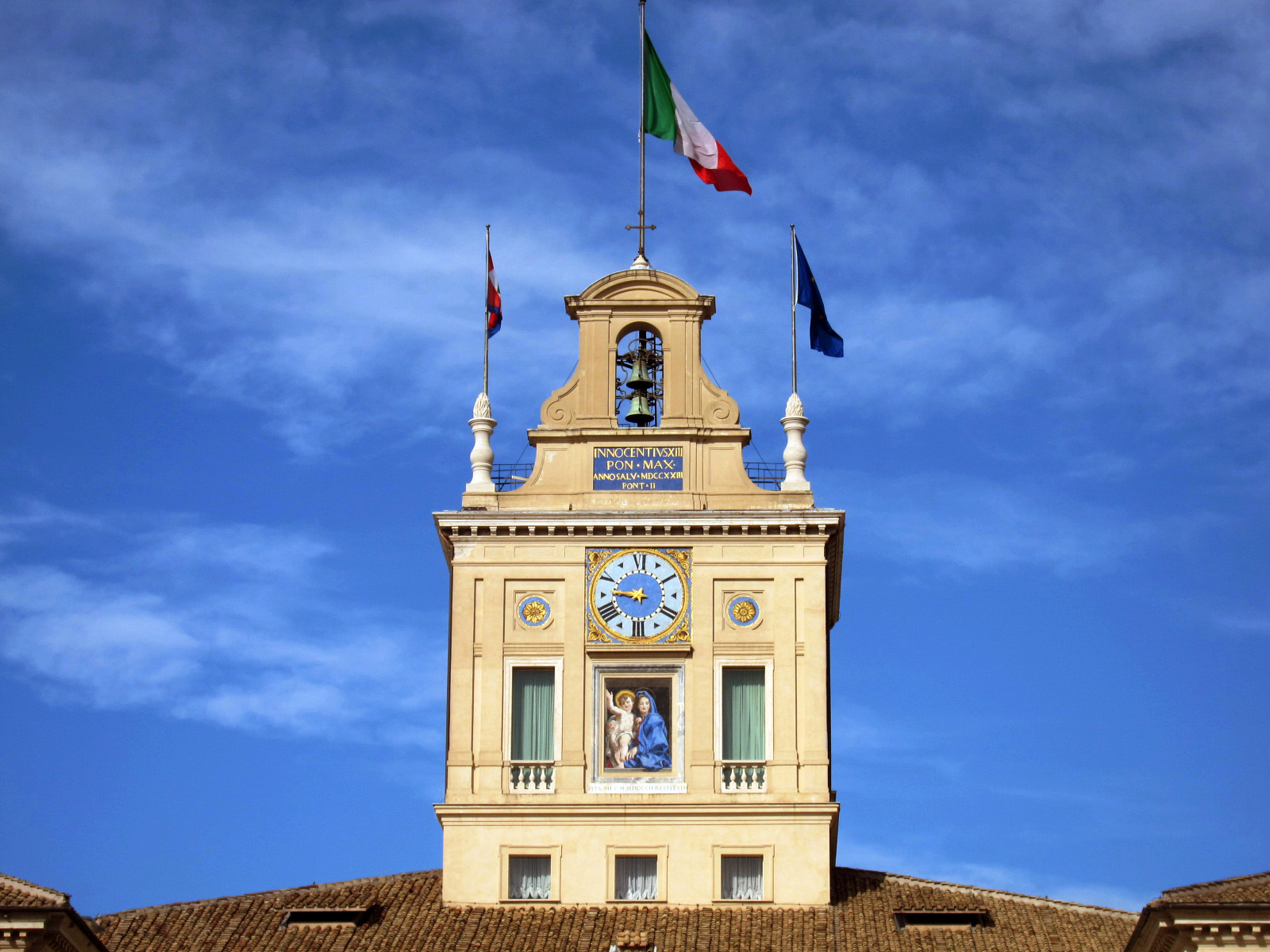 About a ten minute walk from our apartment is the old 16th century Papal palace of the Quirinale Hill, currently used for state functions and the home of the Italian president, currently (since 2006) Giorgio Napolitano. Yes, there were once ancient Roman temples here as well as the baths of Constantine, the last enormous bath complex built in ancient Rome. I the late 1500’s Pope Gregory XIII, best known for Gregorian Chants and the Gregorian calendar, built his summer palace up on the hill. From then on it was enlarged and enlarged.
About a ten minute walk from our apartment is the old 16th century Papal palace of the Quirinale Hill, currently used for state functions and the home of the Italian president, currently (since 2006) Giorgio Napolitano. Yes, there were once ancient Roman temples here as well as the baths of Constantine, the last enormous bath complex built in ancient Rome. I the late 1500’s Pope Gregory XIII, best known for Gregorian Chants and the Gregorian calendar, built his summer palace up on the hill. From then on it was enlarged and enlarged.
It was the seat of government under the Napoleonic rule and then the home to the Italian Kings from the late 1800’s till the time of the Fascists.
The state rooms of the Palace are open to the public on Sundays between 8am-11:30am. We strolled over around 10am and the line was around the entire Piazza, filled with tour groups, which lucky for us, being just two people, we were let in immediately.
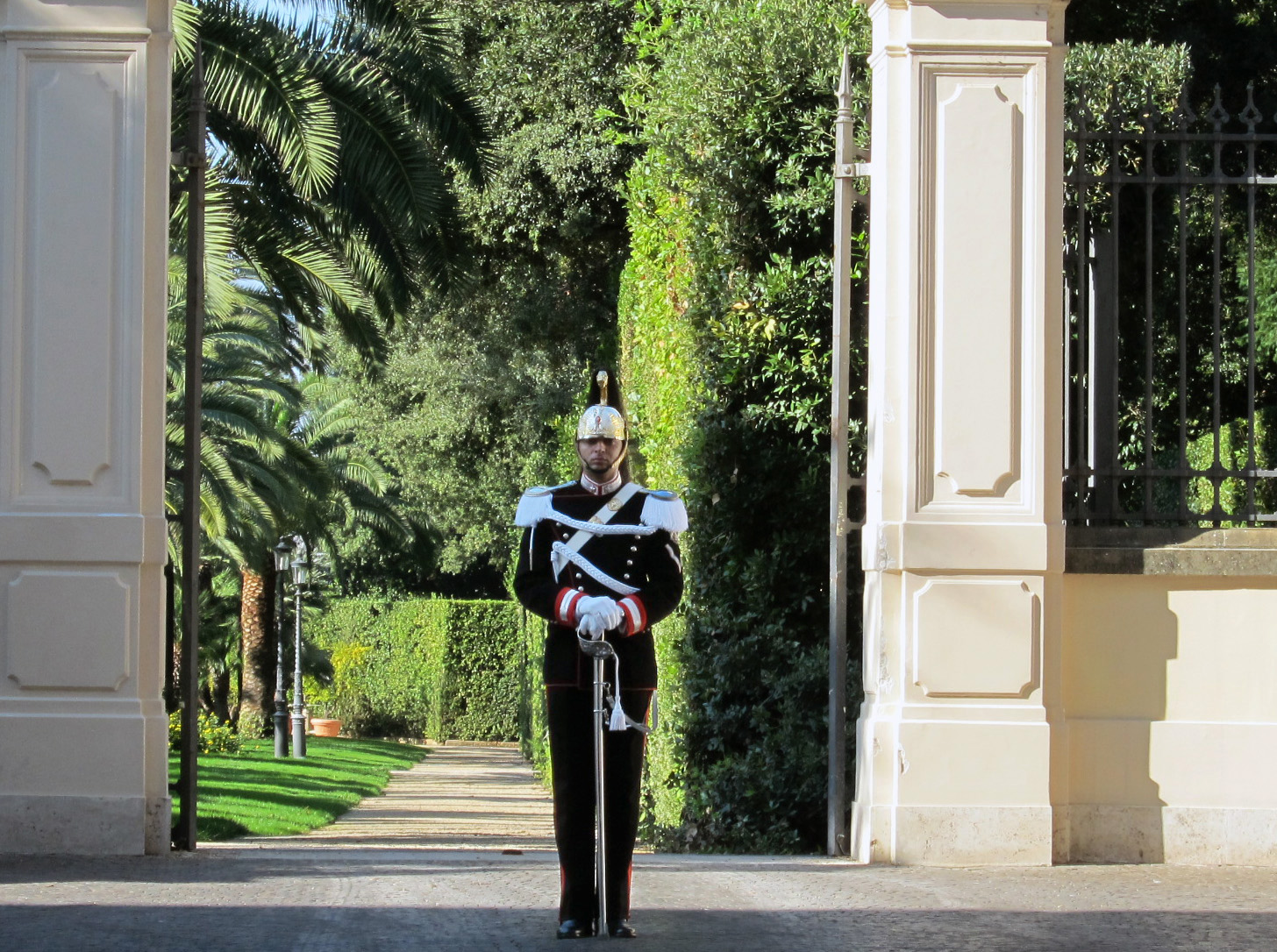 The State Rooms still have some of their 16th century decor but they were stuffy, pompous and too crowded with tour groups. We did the speed tour. For us, the best thing about the Quirinale Palace are the Palace Guards, known as the Corazzieri who stand at attention in their gold dome helmets for hours at a time.
The State Rooms still have some of their 16th century decor but they were stuffy, pompous and too crowded with tour groups. We did the speed tour. For us, the best thing about the Quirinale Palace are the Palace Guards, known as the Corazzieri who stand at attention in their gold dome helmets for hours at a time.
In the 14th century the Corazzieri fought for the King of Savoy. When Vittorio Emanuele II of the House of Savoy became the first King of United Italy he brought the Corazzieri with him. They’ve been with the Quirinale since the late 19th century, still wearing the traditional 19th century uniforms with golden helmets and long swords. In order to even apply for this special service you need to be at least 1.9 meters tall (6’3”). I guess tall people look better standing at attention for hours at a time. The Vatican has the Swiss Guard, the Quirinale has the Corazzieri.
By the way, the changing of the guard at the Quirinale Palaceis at 3:15p (4pm on Sundays and Holidays). It’s a daily pompous affair.
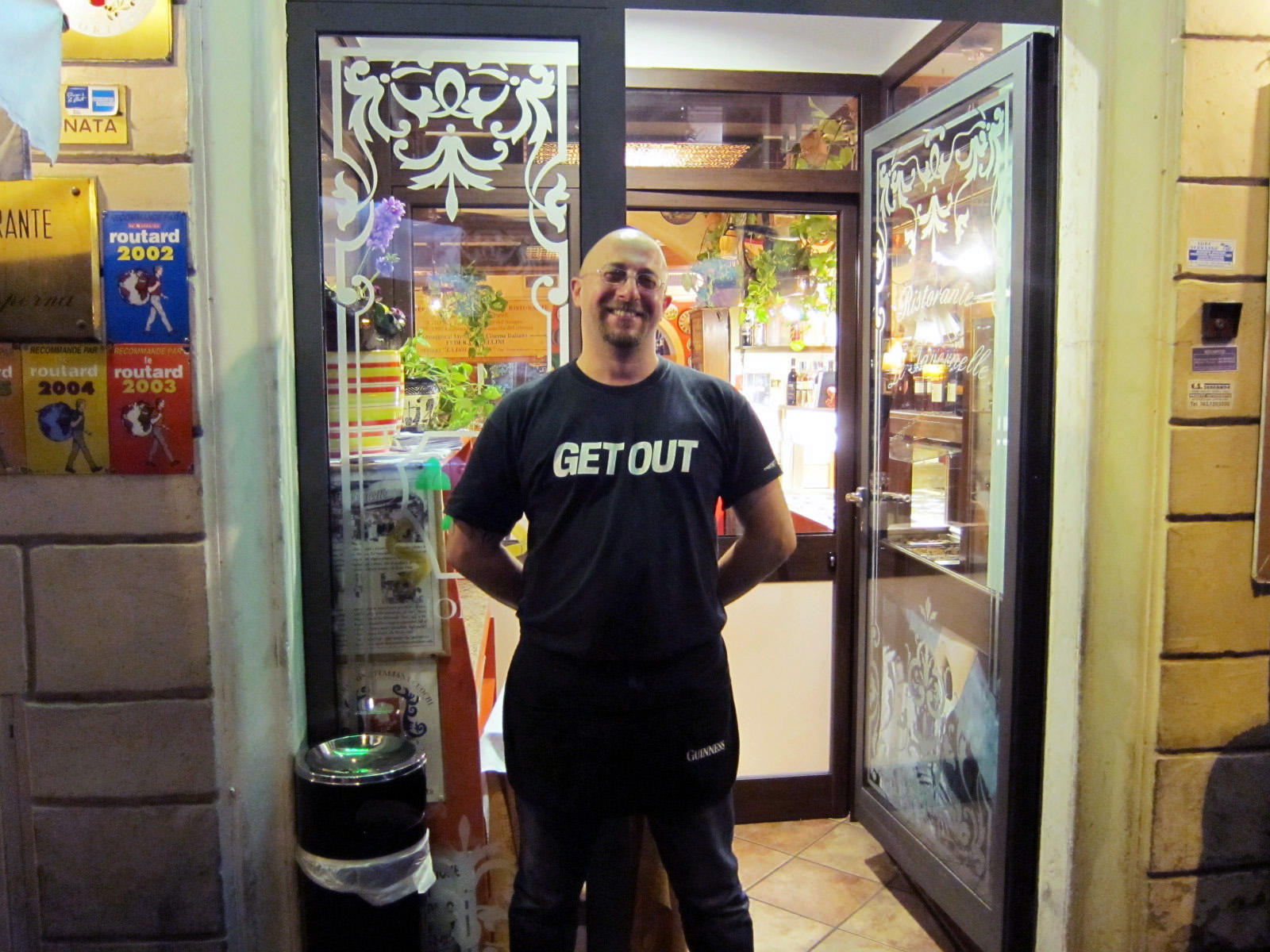 The heart of the Monti is along the streets of the via Urbana, via dei Serpenti, via del Boschetto and via Panesperna. It’s a small area filled with bars, shops and restaurants. We’ve become big fans of some of local places like Le Tavernelles, and Cuoco e Camicia (the cook and the shirt), a nouvelle Italian restaurant that was just opened up by the owner of our rental apartment. He’s the shirt.
The heart of the Monti is along the streets of the via Urbana, via dei Serpenti, via del Boschetto and via Panesperna. It’s a small area filled with bars, shops and restaurants. We’ve become big fans of some of local places like Le Tavernelles, and Cuoco e Camicia (the cook and the shirt), a nouvelle Italian restaurant that was just opened up by the owner of our rental apartment. He’s the shirt.
Ciuri Ciuri is another place we made a lot of visits for best Sicilian pastries (cannoli, casserta, etc) and really really good gelato and granita. They also have a small restaurant but we’ve only been to the sweet shop. It was either fortunate or unfortunate that we always walked by Ciuri Ciuri on our way back to the apartment.
That’s the entrance to Le Tavernelles, our favorite hang. We are big fans of Franco and Mimo, the owners and Franco’s brother, Enrico, the guy at the door with the ‘Get Out” t-shirt. The restaurant is very reminiscent of an old New York City eatery with photos on the wall of visiting celebrities. This restaurant has been a local favorite since 1870. The cacio e pepe (cheese and pepper pasta) was divine, the scallopini unequalled and the putarella (chicory) salad became one of Gretchen’s favorites.
On November 3rd we walked past the Coliseum, past the Triumphal arch of Constantine, down the via San Gregorio between the Caelian and Palatine Hills and over to the Circo Massimo (Circus Maximus), about a 15 minute walk from our apartment.
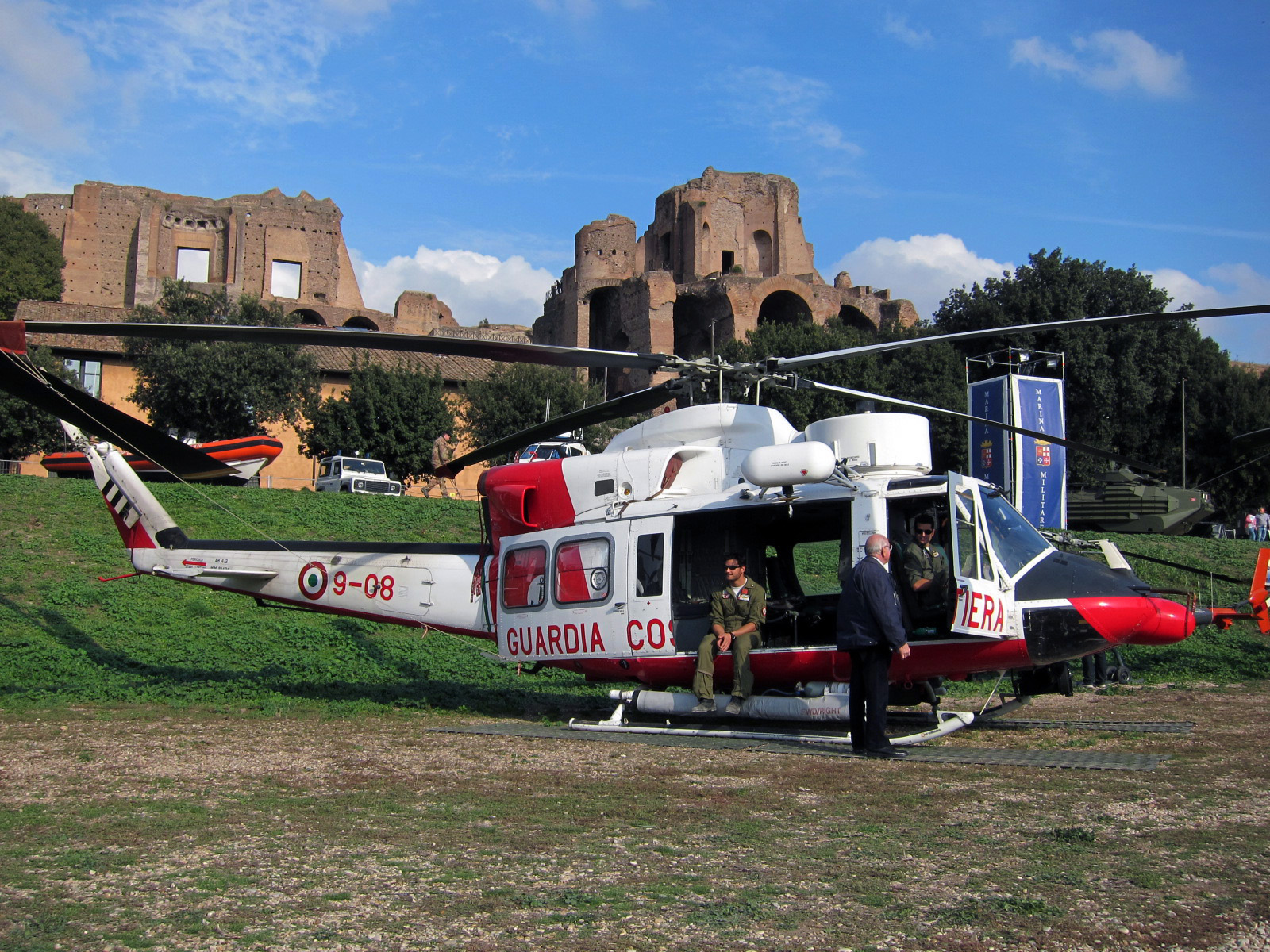 The Armed Forces were loading in a grand display of military might; tanks, helicopters, rocket launchers into the Circo Massimo (Circus Maximus). It was a special version of the National Defense Day (Armed Forces Day) Holiday to coincide with the 150th anniversary of the United Italy. The ancient racetrack was filled with tents and equipment ready to show the Romani what their taxes are used for. Gretchen loves this stuff. She could have spent the entire afternoon watching them loading in the large pieces.
The Armed Forces were loading in a grand display of military might; tanks, helicopters, rocket launchers into the Circo Massimo (Circus Maximus). It was a special version of the National Defense Day (Armed Forces Day) Holiday to coincide with the 150th anniversary of the United Italy. The ancient racetrack was filled with tents and equipment ready to show the Romani what their taxes are used for. Gretchen loves this stuff. She could have spent the entire afternoon watching them loading in the large pieces.
November 4th is the actual date of National Defense Day (Armed Forces Day) and the large military equipment against the panorama of Domitian’s Palace on the Palatine was a pretty amazing sight.
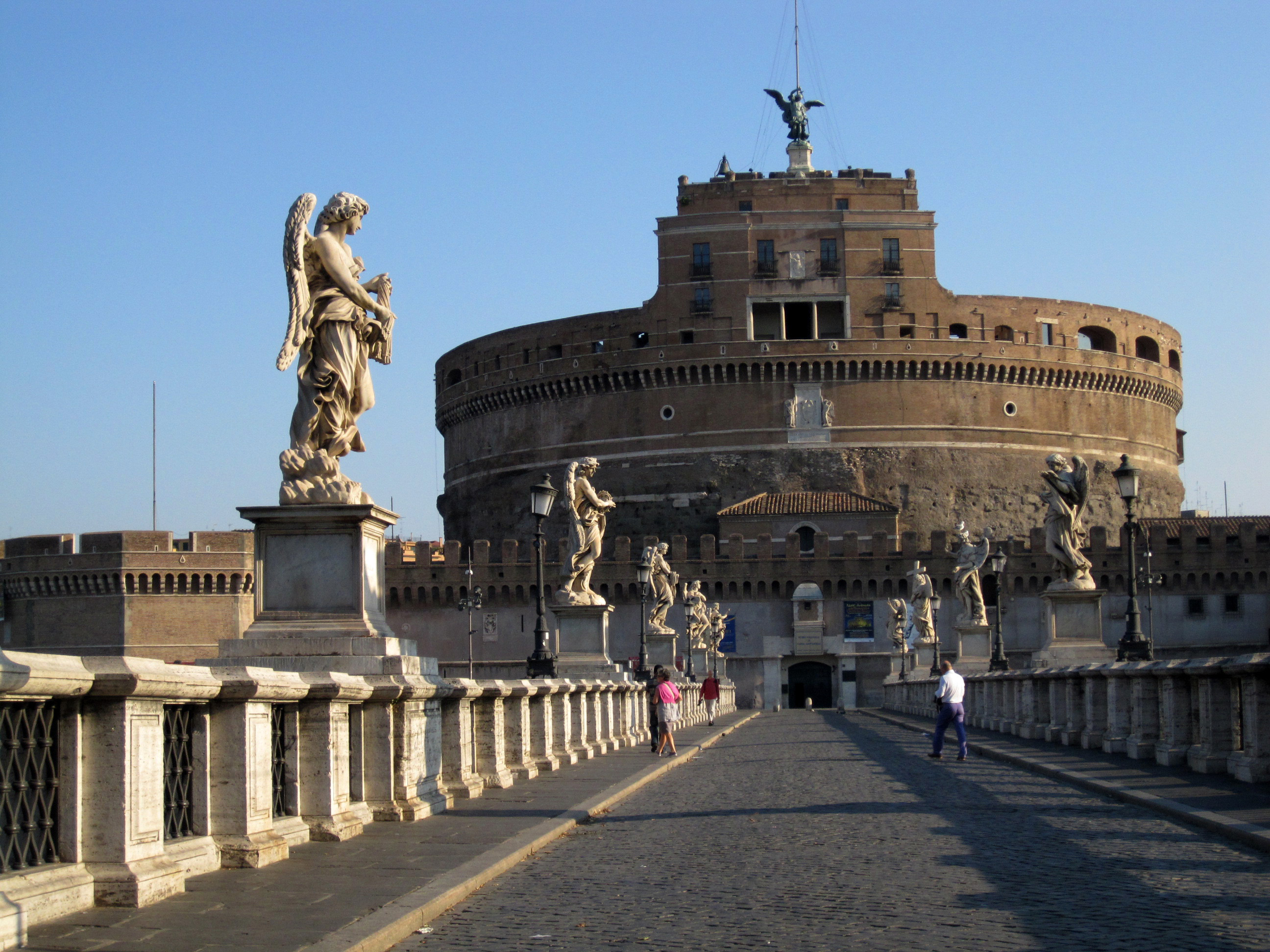 Castel Sant’Angelo and the Ponte Sant’Angelo
Castel Sant’Angelo and the Ponte Sant’Angelo
The Castel Sant’Angelo bridge goes back to 134AD when it was the Aelian Bridge connecting the Campo Marzio to Hadrian’s Tomb (now Castel Sant’Angelo). The jubilee of 1450 was so successful, thousands of pilgrims crowded into the bridge to get over to St Peter’s Basilica. The crowd got out of control. Hundreds were trampled. Hundreds more drowned when the balustrades gave way.
In 1535 the first of the statues appeared on the bridge, stucco apostles and figures from the old testament but in 1669 Pope Clement IX commissioned Bernini to replace the old worn out figures with the 10 statues we see there today, angels holding instruments used in the Passion of Christ. Bernini made just two of them, neither of which ever made it to the bridge. They were kept by Clement IX and are now in the church of Sant’Andrea delle Fratte. Copies of the two Bernini angels were put on the bridge.
Throughout the 16th and 17th centuries, hundreds of criminal’s heads on pikes were nestled between these heavenly angels. When Pope Sixtus V took office in 1585, it was the custom (as was the practice of a newly ordained Pope) to pardon all the criminals in the jails in honor of his coronation. Sixtus V instead announced “While I live, every prisoner must die.” And die they did. It was said that the heads on the bridge were “more numerous than the melons in the market”
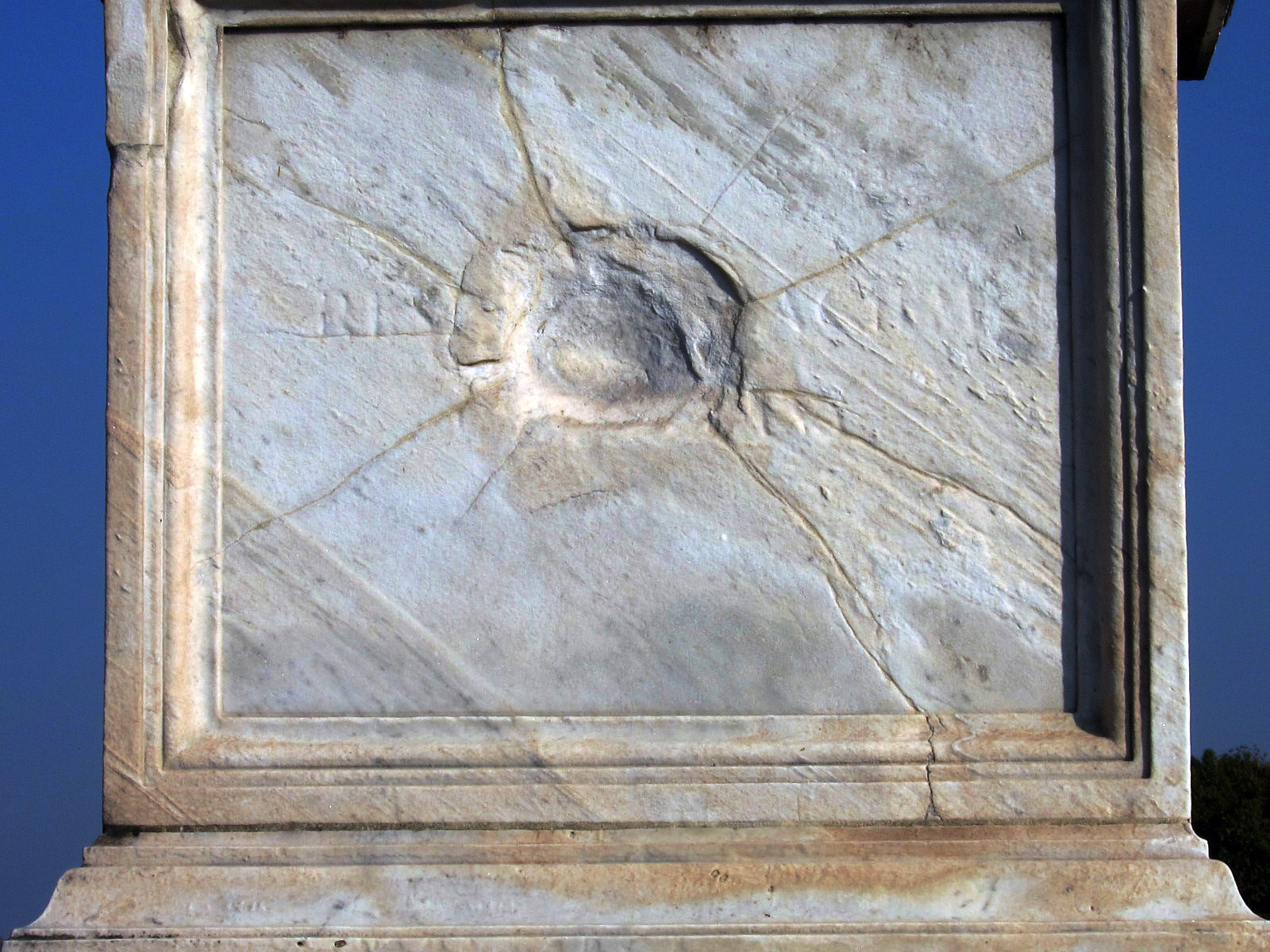 As we crossed the bridge we could still see the mark of a cannonball at the base of one of the angel statues. It was fired during the papal defense of the Vatican in 1870. The statue was knocked into the river but it was repaired and replaced. I won’t tell you which statue it was. You’ll have to look for yourself. Its pretty easy to find.
As we crossed the bridge we could still see the mark of a cannonball at the base of one of the angel statues. It was fired during the papal defense of the Vatican in 1870. The statue was knocked into the river but it was repaired and replaced. I won’t tell you which statue it was. You’ll have to look for yourself. Its pretty easy to find.
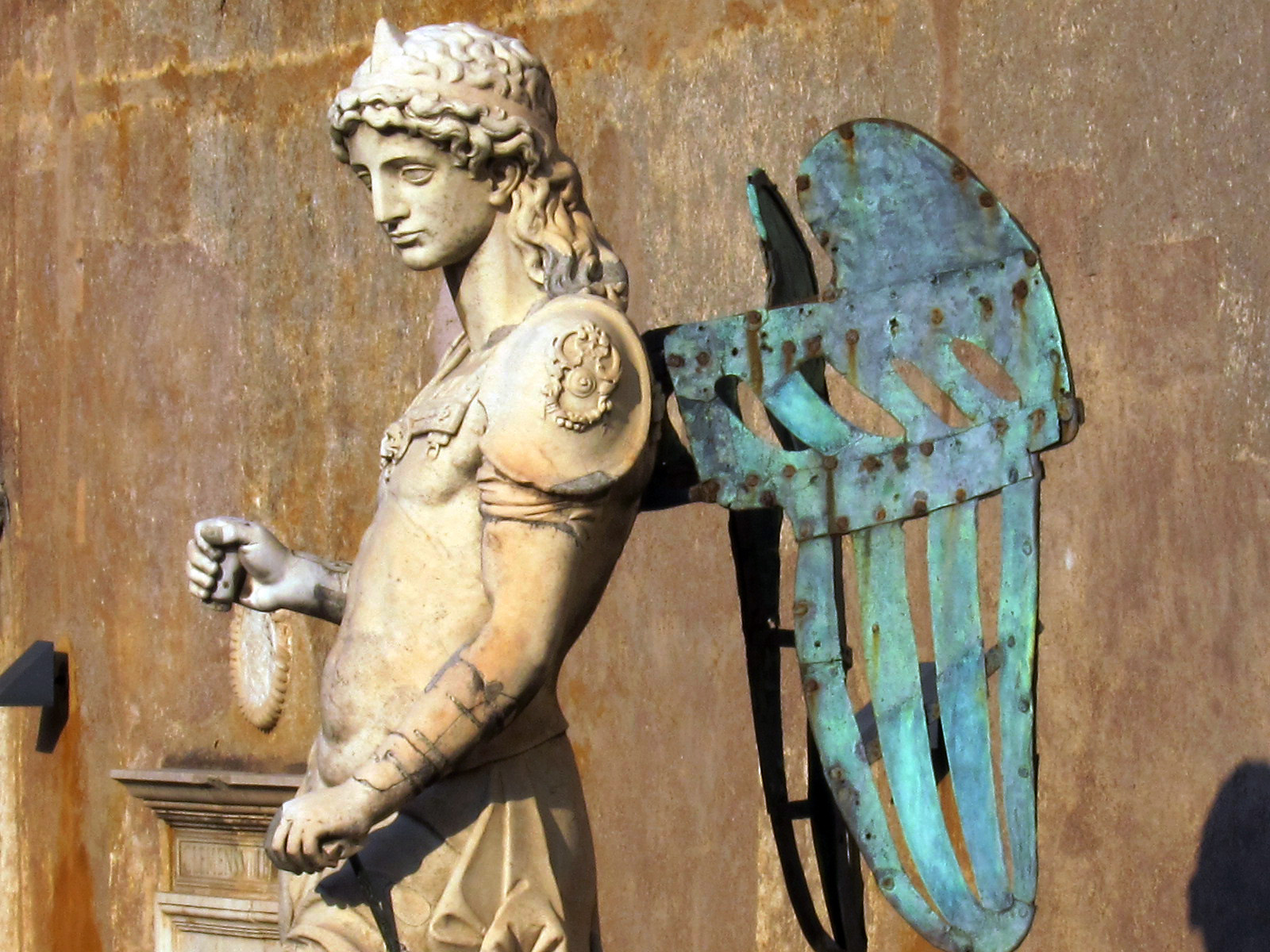 In 590 Pope Gregory the Great was making a visit to the churches of Rome, making a plea to god to end the plague.
In 590 Pope Gregory the Great was making a visit to the churches of Rome, making a plea to god to end the plague.
While on his way to the Basilica of St Peter, according to those who were there, the archangel Michael appeared over the military castle built over Hadrian’s tomb and sheathed his sword, signifying the plague would come to an end. The castle was renamed Sant’Angelo (Saint Angel).
In the 14th century the Popes built a long corridor from the Vatican to the fortress, kind of an escape route in case of emergency. This “Passetto di Borgo”, was used twice; in 1494 when Alexander VI Borgia escaped the forces of the French King Charles VIII and in 1527 when Pope Clement VII Medici escaped the anarchy of the troops of the Holy Roman Emperor during the Sack of Rome. The Passetto is sometimes open to the public (for a fee) in the summer months. Unfortunately, it wasn’t open in November when we were there.
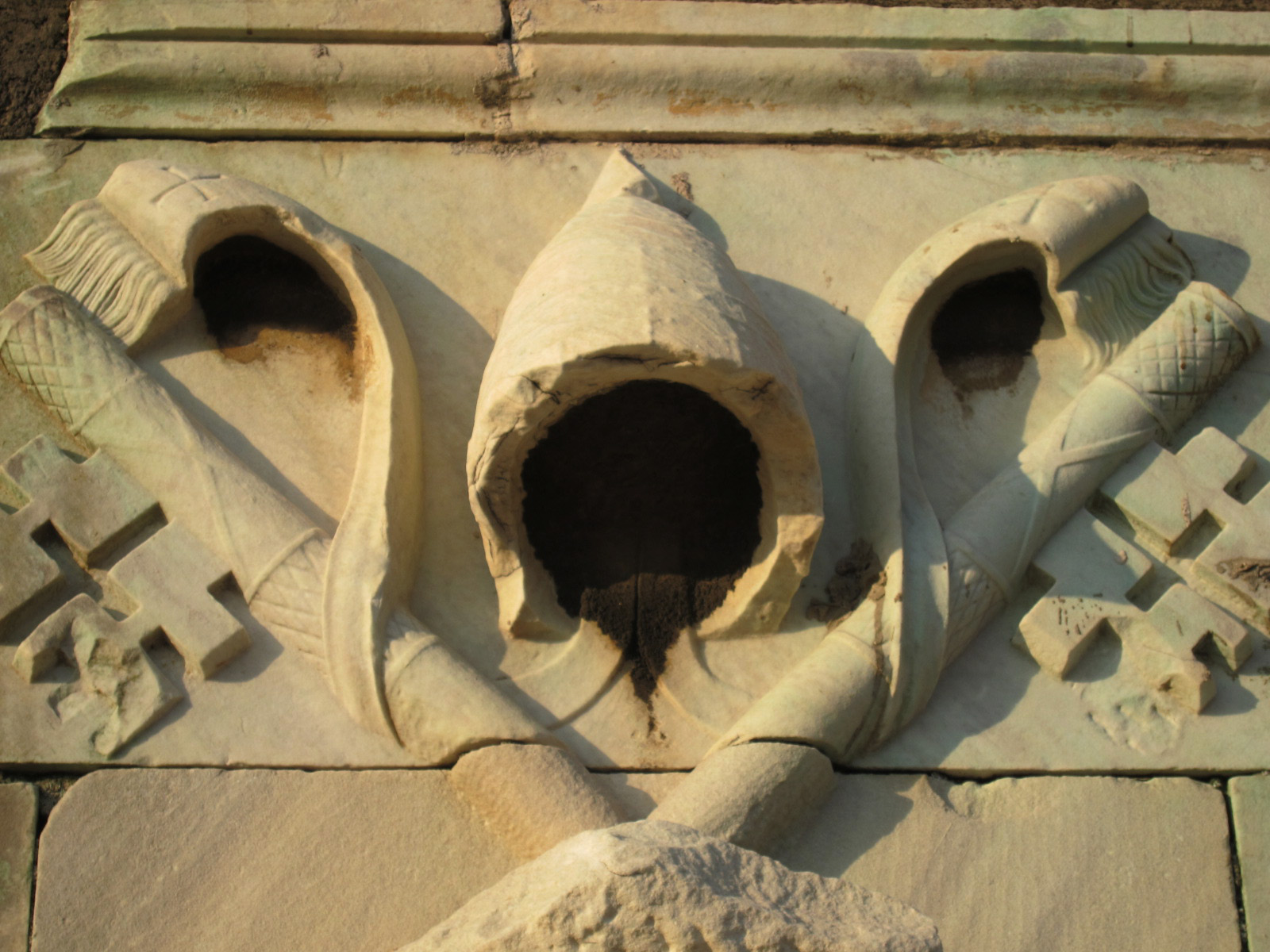 The Castle was decommissioned in 1901. Now it’s a really great museum with amazing views of Rome from the rooftop, the same rooftop where Puccini’s Tosca jumped to her death.
The Castle was decommissioned in 1901. Now it’s a really great museum with amazing views of Rome from the rooftop, the same rooftop where Puccini’s Tosca jumped to her death.
Castel Sant’Angelo is filled with papal history and the crests of the Medici balls, Farnese fleur-de-lis, Barberini Bees and quite a few others. We even found a Papal crest that was defaced, as if to erase a certain Pope from the memory of the Castel. I just don’t know which one it was? Maybe the French defaced the crest of Clement VII when they held him prisoner here.
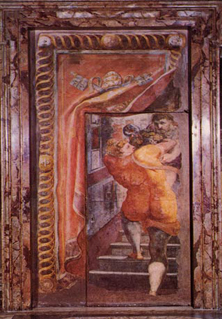 In the Sala Paolina, the grand apartments of the 16th century Pope Paul III Farnese the grand Salon were allegories to Alexander the Great (Pope Paul III used to be Alexander Farnese), Alexander on one side and Hadrian on the other. There are also two cartoon tromp l’oeil frescos painted over doors leading out of the salon; Pellegrino Tibaldi’s self portrait on one and Perino del Vega’s two servants sneaking away up the stairs over the another. Del Vega was one of Raphael’s best students and worked on many of the salons in the Castel. He died a few months after finishing the grotesque paintings of the Sala d’Apollo (closed during our visit).
In the Sala Paolina, the grand apartments of the 16th century Pope Paul III Farnese the grand Salon were allegories to Alexander the Great (Pope Paul III used to be Alexander Farnese), Alexander on one side and Hadrian on the other. There are also two cartoon tromp l’oeil frescos painted over doors leading out of the salon; Pellegrino Tibaldi’s self portrait on one and Perino del Vega’s two servants sneaking away up the stairs over the another. Del Vega was one of Raphael’s best students and worked on many of the salons in the Castel. He died a few months after finishing the grotesque paintings of the Sala d’Apollo (closed during our visit).
The guard in the Sala Paolina took a special liking to us and waved us away from the others, ushering us to a small passageway, down the a narrow staircase and into the Pope’s bathroom, a marble inlaid chamber and tub built for Clement VII somewhere around 1530. The floor and the water were both heated by the stove below. This was a very clever 16th century indoor bathroom. I hope his holiness got to use it when he was held captive for 6 months in the Castle Sant’Angelo during the Sack of Rome in 1527.
Another one of the hidden treasures of the city s the Palazzo Colonna. It faces the Piazza dei Santi Apostoli off via del Corso but the entrance to the tour is from the back of the Palazzo, on via della Pilotta. This is a private family home and probably the most splendid Baroque palace in the city. The State Rooms of the Palazzo Colonna are opened to the public on Saturday mornings. You can tour the private apartments as well but you need a group of at least 10 people, or pay for 10 people.
After the Great Catholic Schism of the 14th and 15th centuries, Pope Martin V Colonna brought the seat of the Catholic Church back to Rome. The city was a mess. The Papal in Avignon, France wasn’t very interested in the urban projects in Rome. When Martin V brought it all back to Rome, he started his urban renewal with his own Palazzo. Some of the 15th century renovations are almost evident, but most of it has been updated to a wild 16th and 17th century baroque splendor palace mostly design by Gian Lorenzo Bernini. Palazzo Colonna was redesigned about 10 years before the hall of mirrors at Versailles and there have been a number of comparisons, mostly because Lorenzo Colonna was married (for a short time) to Maria Mancini, one of the loves of King Louis XIV. Actually the Hall of Mirrors in the Palazzo Colonna is in much better condition that the Versailles version. This Palace is still in the Colonna family and it has been thoroughly maintained.
The Colonna Palace has been in the forefront of Roman high society since the 15th century and the parties have been famous. According to Pope Clement VII de Medici, who attended a party here in the early 16th century, he stood on the balcony and watched the guests below chasing pigs, throwing cold water onto them to slow them down. Then, to join in the fun, Clement VII threw small birds from the balcony down to the guests. I never knew if the birds were alive or cooked.
In 1730, at a party given in honor of the son of the King of Poland, male guests were required to urinate into two antique urns at the front door as a precaution against possible damage to the fine interior. Yes, it got that out of control.
The Great Gallery is filled with recognition and adoration to Marcantonio II Colonna, the commander of the Italian navy during the Battle of Lepanto in 1571 when the forces of the Holy Roman Emperor defeated the navy of the Ottoman Empire. Of the 68,000 troops of the Holy Roman Empire, the Italian navy comprised about 5,000 of them. But the way it looks in the Great Gallery, Marcantonio II was the hero of the battle.
 Aside from being one of the most impressive baroque halls we’ve ever been to, the Great Gallery has some really interesting pieces of art to visit. This is one of the largest private collections of art in all of Italy. Just the “Bean eater” by Annibale Caracci is worth the price of admission.
Aside from being one of the most impressive baroque halls we’ve ever been to, the Great Gallery has some really interesting pieces of art to visit. This is one of the largest private collections of art in all of Italy. Just the “Bean eater” by Annibale Caracci is worth the price of admission.
During the restoration of many of the art pieces in 2002, it was discovered that a few of the 16th century paintings, including “Venus, Cupid and Satyr” by Bronzino, had clothing painted onto the nudes. Apparently the reformation of the 16th century had its effect on the art collection of the Colonna family. A photo of the old clothed version sits next to the newly restored nude versions. Its really wonderful.
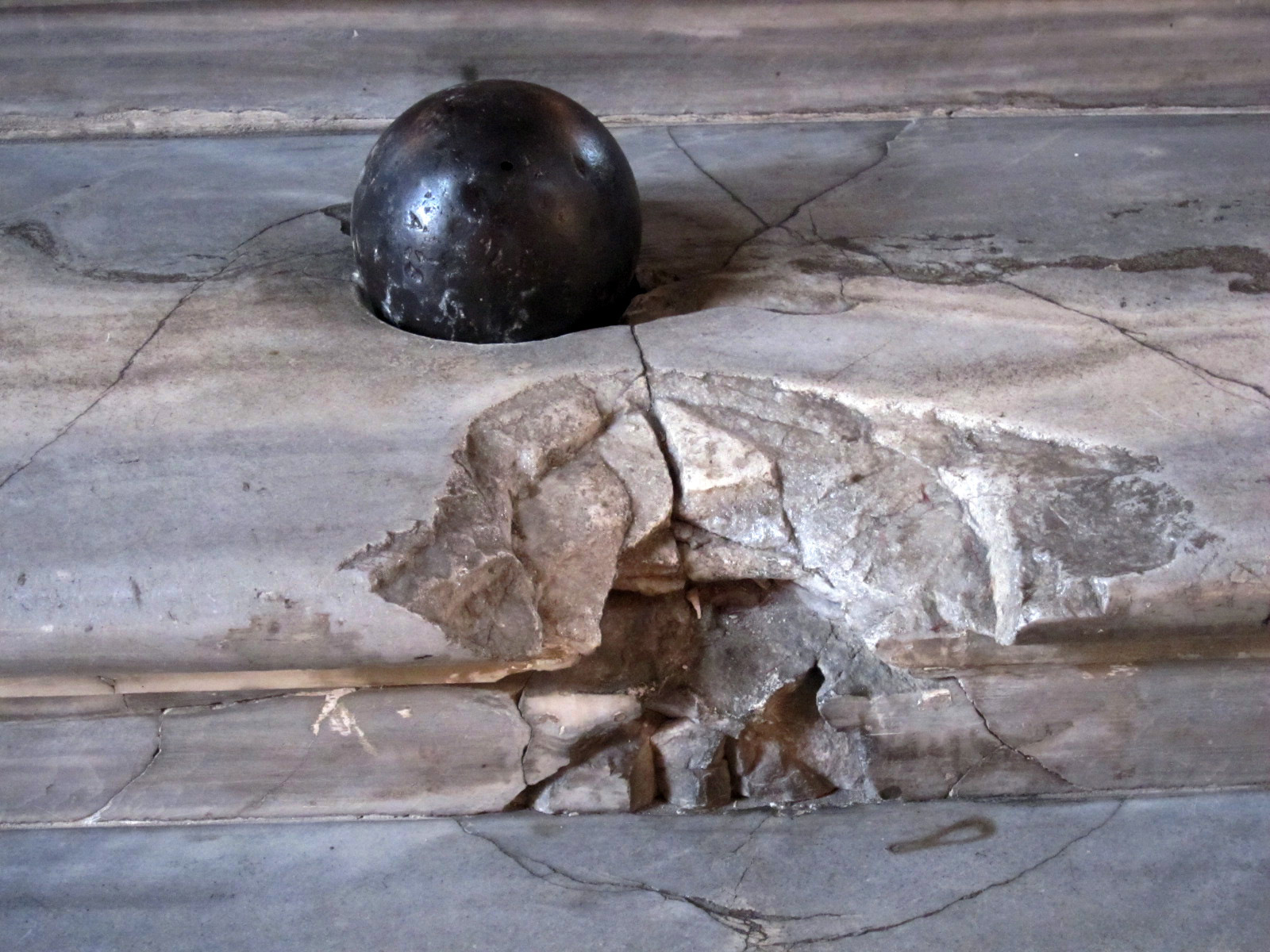 Another great detail of the Great Gallery is on the stairs leading from the gallery to the throne area. There is a cracked step with a cannonball neatly displayed. The cannonball landed here on June 24, 1849 when the French were shelling the city from the Janiculum hill across the river.
Another great detail of the Great Gallery is on the stairs leading from the gallery to the throne area. There is a cracked step with a cannonball neatly displayed. The cannonball landed here on June 24, 1849 when the French were shelling the city from the Janiculum hill across the river.
The canons were aimed at the Quirinale Palace but one of the balls came through the Palazzo Colonna window facing the via del Corso and landed on the steps, just a few feet away from where the Colonna family thrones would have been. The Colonna thought it was a divine statement to their supreme survival and so it has remained here ever since.
The Room of the Column (the emblem of the Colonna family) was the throne room for the Prince Filippo II Colonna. It was also where Audrey Hepburn bid farewell to Gregory Peck in the final scene of “Roman Holiday”.
As part of the National Defense Day celebration, a large free concert was held in Piazza del Popolo featuring the music of Ennio Morricone, an orchestral and choral retrospective of his music and directed by him, Ennio Morricone. This is an amazing body of work; Fistful of Dollars, The Good the Bad and the Ugly, For a Few Dollars More, Once Upon a time in the West, Once Upon a time in America, Cinema Paradiso, The Mission and a lot of Italian films I never knew about. The concert was free, there were thousands of people in the Piazza. They really know how to stage an event in this city. They’ve been doing it for well over 2000 years.
 We can walk these streets so many times and look at the same building so many times and always find something new. We went to the church of Santa Maria del Popolo one day and discovered that on one of the smaller doors to the side of the main entrance, the name of Pope Sixtus IV misspelled. It’s true. One side of the building has SIXTUS, the way it should be and the other side (to the left of the main entrance is written SIXUS. They forgot the T. The church construction was finished in 1477. Pope Alexander VII (Chigi) had Bernini update the facade in 1660 but he apparently left it alone. Maybe Bernini thought it was funny. We sure did.
We can walk these streets so many times and look at the same building so many times and always find something new. We went to the church of Santa Maria del Popolo one day and discovered that on one of the smaller doors to the side of the main entrance, the name of Pope Sixtus IV misspelled. It’s true. One side of the building has SIXTUS, the way it should be and the other side (to the left of the main entrance is written SIXUS. They forgot the T. The church construction was finished in 1477. Pope Alexander VII (Chigi) had Bernini update the facade in 1660 but he apparently left it alone. Maybe Bernini thought it was funny. We sure did.
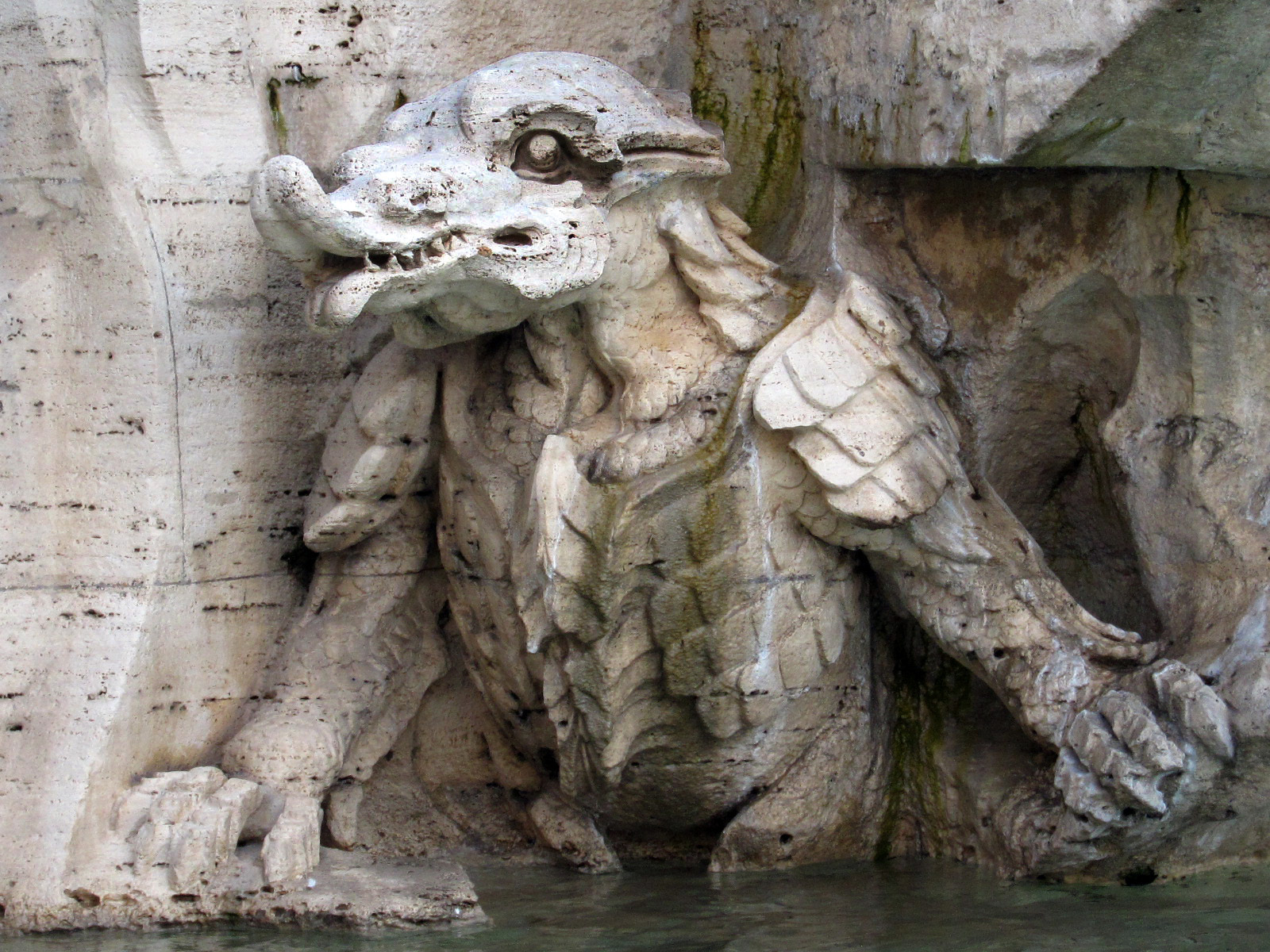 Another new discover of things we’ve looked at over and over. We’ve looked at Bernini’s Fontana dei Quattro Fiumi (the fountain of the four rivers) in Piazza Navona maybe a hundred times. Each river is represented by a “River God” statue along with animals and plants that might pertain to the river and the land where it flows. The four rivers are the Nile in Africa, the Ganges in India, the Danube in Europe and the Rio de la Plata in America. The statue for the Rio de la Plata (river of silver) is sitting on a pile of coins showing the wealth to be obtained in the new world. The fountain was created in the late 1600s when the Americas were providing a lot of new wealth to the Church. The interesting part is that a 17th century rendition of an armadillo appears under the Rio de la Plata river god. Neither Bernini nor any of his team of sculptors had ever seen an armadillo so they designed it based on the accounts of those who came back from the American expeditions. What tales they must have heard. The armadillo looks like some kind of armored futuristic space creature form some 1980’s sci-fi comic book.
Another new discover of things we’ve looked at over and over. We’ve looked at Bernini’s Fontana dei Quattro Fiumi (the fountain of the four rivers) in Piazza Navona maybe a hundred times. Each river is represented by a “River God” statue along with animals and plants that might pertain to the river and the land where it flows. The four rivers are the Nile in Africa, the Ganges in India, the Danube in Europe and the Rio de la Plata in America. The statue for the Rio de la Plata (river of silver) is sitting on a pile of coins showing the wealth to be obtained in the new world. The fountain was created in the late 1600s when the Americas were providing a lot of new wealth to the Church. The interesting part is that a 17th century rendition of an armadillo appears under the Rio de la Plata river god. Neither Bernini nor any of his team of sculptors had ever seen an armadillo so they designed it based on the accounts of those who came back from the American expeditions. What tales they must have heard. The armadillo looks like some kind of armored futuristic space creature form some 1980’s sci-fi comic book.
Another of our many new discoveries on this visit was the Palazzo delle Esposizioni on Via Nazionale, near our apartment rental in the Monti. We saw a wonderful retrospective of Soviet Art from the 1940 to the 1970. The museum was built in 1883. It closed in 2003 for a total renovation and reopened in 2008. It might be the best exhibit space in Rome. The rooms are large and well lit. Aside from the gallery space there is a cinema and a recital hall. You can also buy a ticket that includes the Scuderia Quirinale, a short walk away which also houses temporary exhibitions.
Yes, there are great permanent collections in the Vatican, the Galleria Borghese, the Capitoline and others, but check out the temporary exhibits. They are lovingly put together and don’t usually have the crowds of the big ticket museums.
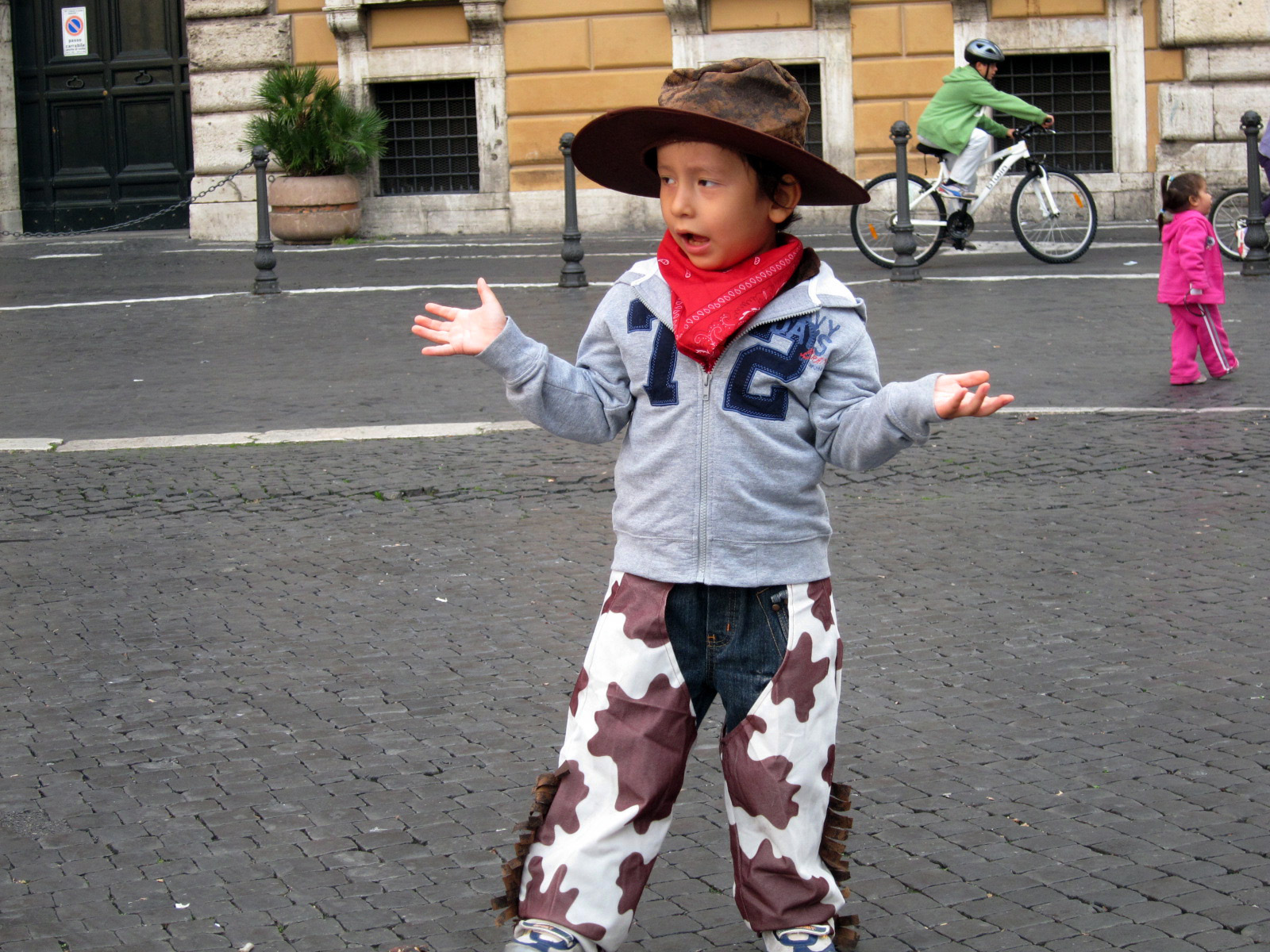 One final note on Roman food, and we sure like to eat a lot of it. This is a foodie town. There are ultra high end places like La Pergola, Il Pagliaccio, Hosteria dell’Orso di Gaultiero Marchese and a few others but you’ll pay at least €100 per person, but there are wonderful local places where the food is always fresh and always delicious. I’m not saying all restaurants in Rome are great. We’ve eaten at our share of bad meals here. Sometimes those recommendations in the New York Times or on Tripadvisor or other websites are just really bad.
One final note on Roman food, and we sure like to eat a lot of it. This is a foodie town. There are ultra high end places like La Pergola, Il Pagliaccio, Hosteria dell’Orso di Gaultiero Marchese and a few others but you’ll pay at least €100 per person, but there are wonderful local places where the food is always fresh and always delicious. I’m not saying all restaurants in Rome are great. We’ve eaten at our share of bad meals here. Sometimes those recommendations in the New York Times or on Tripadvisor or other websites are just really bad.
Speaking of Gaultiero Marchese, the man credited with the introduction of nouvelles cuisine in Italy had created two special burgers for McDonald’s. The promotion ran for only a few weeks but we were there when it happened. We love Marchesi and we’ve paid tribute (more than a few times) to him at his flagship restaurant near Lago D’Iseo in the north of Italy, and although we did go into a McDonald’s and looked at all the advertising, we couldn’t bring ourselves to dive into a Vivace or Allegro burger.
We did, however, enjoy a couple of lunches at Cavalier da Gino near Parliament Square. This is one of those lunch joints frequented by politicians. We were there when the Italian Parliament voted to remove Silvio Berlusconi and Gino’s was buzzing with political intrigue. The food is typical Roman, the service is fast and you always need a reservation, unless you can talk your way into one like we did.
Another great discovery was the Café at the Chiostro del Bramante, the cloister connected to the Santa Maria della Pace Church, in Piazza Santa Maria della Pace, a little northwest of Piazza Navona. The Chiostro (Cloister), built in 1500 is the first work of Donato Bramante in Rome. Bramante went on to architectural greatness with structures like the 1502 Tempietto in San Pietro in Montorio, the 1506 Basilica of St Peters and the 1506 Cortile del Belvedere at the Vatican. The Chiostro is currently used as an exhibit space for touring art shows. The cafe is up the stairs, overlooking the old cloister. It’s quiet and the food is excellent. It’s a great way to get away from the tourist crowd. And, if you like a good miracle story, the Santa Maria della Pace Church has a great one. It was once the church of the water carriers and was called Sant’Andrea de Aquarentariis. In 1482 a fight broke out in the portico where one of the columns was frescoed with an image of the Virgin Mary. One of the youths threw a stone at another. The stone missed its intended mark and instead struck the fresco of the Holy Madonna, who in turn, began to bleed. The miracle not only stopped the fight, it prompted the rebuilding of the church and renaming it as The Santa Maria della Pace.

You must be logged in to post a comment.